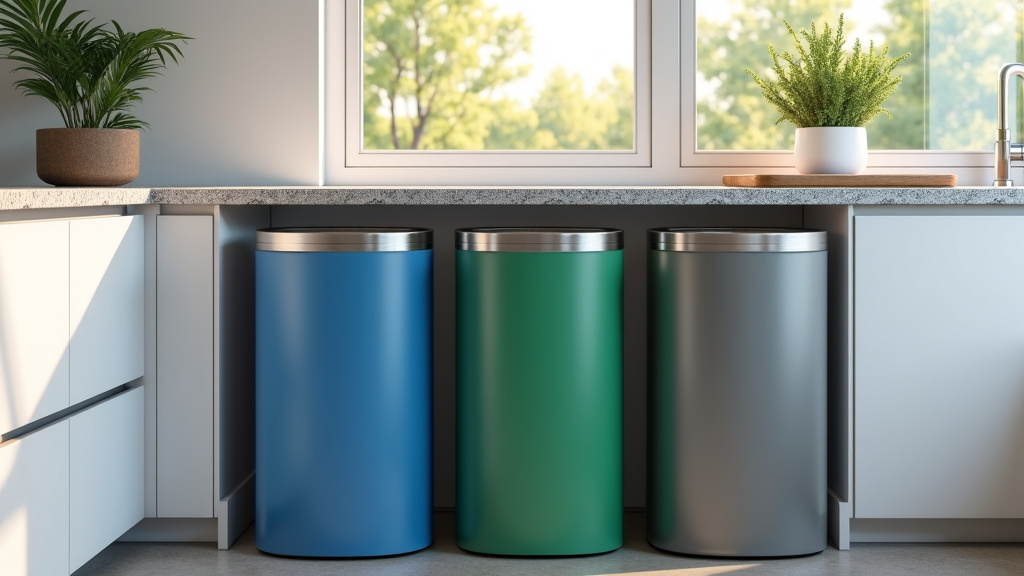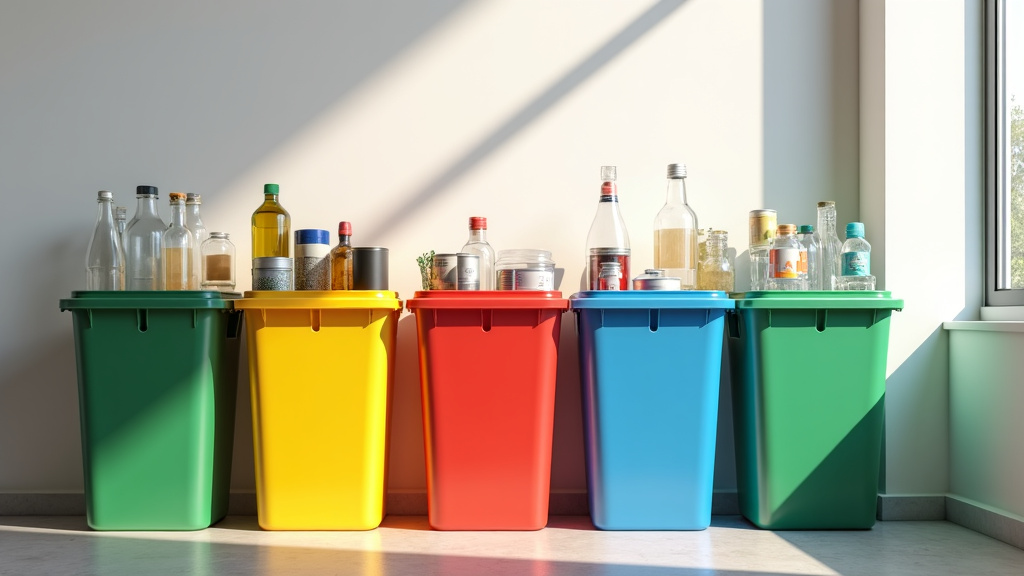5901 Botham Jean Blvd, Dallas, TX 75215
Recycling Practices at Home: A Comprehensive Guide
April 1, 2025Did you know the average American generates about 4.9 pounds of waste per day? With such figures, implementing effective recycling practices at home is crucial. By adopting smart recycling habits, we can significantly reduce waste, conserve resources, and contribute to a more sustainable future.
Recycling at home goes beyond merely tossing items into a blue bin. It involves understanding the process, knowing what can and cannot be recycled, and implementing efficient systems to maximize our efforts. From proper sorting techniques to composting organic waste, there are many strategies households can employ to minimize their environmental impact.
This guide will explore various tips and techniques to help you become a recycling pro at home. We’ll cover the basics of setting up an effective recycling system, discuss commonly recyclable materials, and highlight often overlooked opportunities for reducing waste.
Setting Up an Efficient Home Recycling System

Creating a well-organized recycling system at home is essential for sustainable waste management. By implementing a thoughtful setup, recycling can become an effortless part of your daily routine. Here’s how to establish an efficient home recycling system for your household.
Designate Recycling Areas
The first step is to choose strategic locations for your recycling bins. Place them in high-traffic areas where waste is commonly generated. The kitchen is often the primary spot for recyclables, but consider other areas as well.
Place smaller recycling containers in home offices, bathrooms, and bedrooms to capture recyclables throughout your living space. This ensures recycling is convenient and accessible, increasing participation.
If space is limited, look for creative solutions like under-sink organizers or over-the-door racks to maximize vertical space. An effective system doesn’t require large bins; it just needs to be well-organized and accessible.
Choose the Right Recycling Bins
Selecting appropriate bins is crucial for maintaining an organized system. Opt for clearly labeled and, if possible, color-coded bins to distinguish between different recyclables. This visual organization helps streamline sorting and reduces confusion.
Consider separate containers for paper, plastics, glass, and metals. If your local program allows commingled recycling, fewer bins may be needed. Always check your municipality’s guidelines to ensure your setup aligns with local requirements.
Durability is important when choosing bins. Select containers that withstand daily use and are easy to clean, maintaining a hygienic area and preventing odors.
Establish a Sorting System
Proper sorting is key to effective recycling. Create a simple, clear system that all household members can follow. Start by educating everyone about which materials are recyclable in your area, as guidelines can vary.
Implement a ‘clean and dry’ rule for recyclables. Rinse containers to remove food residue and ensure items are dry before placing them in the bin. This prevents contamination and ensures recyclables are processed instead of sent to landfill.
Consider creating a visual guide near your recycling station to remind family members of proper sorting techniques. This can be helpful for children or guests unfamiliar with your system.
Develop a Recycling Routine
Consistency is key. Establish a schedule for emptying your indoor bins and taking them to your curbside collection point or local center. This prevents overflow and keeps areas clean and organized.
Assign recycling responsibilities to household members on a rotating basis. This not only distributes the workload but also instills habits in children and reinforces sustainable practices for everyone.
Regularly review and update your system as needed. Stay informed about changes in local guidelines and adjust your system to ensure efficiency and compliance.
Minimize Waste at the Source
Reducing waste at its source is crucial. Encourage mindful consumption habits and choose products with minimal packaging.
Create an ‘upcycle station’ where gently used items can be repurposed or donated instead of discarded, extending product life and reducing waste.
By implementing these strategies, you’ll create a comprehensive recycling system that benefits the environment and fosters sustainability within your household. Remember, every small effort counts towards a greener future.
| Feature | Benefit | Example Bin |
|---|---|---|
| Automatic Sorting | Reduces contamination, increases efficiency | TrashBot |
| Sorting Accuracy | High accuracy ensures proper diversion | TrashBot – 96% |
| Built-in Screen | Educates users on practices | TrashBot |
| Data Collection | Provides analytics for optimization | TrashBot |
| Customization | Adapts to specific needs | TrashBot |
Common Household Items and How to Recycle Them

Proper recycling starts at home, but knowing what can and can’t be recycled is often confusing. Let’s break down some common household items and their proper recycling methods to help you become a recycling pro.
Plastics: Not All Are Created Equal
Plastic recycling can be tricky, but understanding plastic types makes it easier. Look for the recycling symbol with a number inside—this is your guide to recyclability.
PETE (1) and HDPE (2) plastics are widely recyclable. These include water bottles, soda bottles, and milk jugs. Rinse them out and toss them in your recycling bin.
PVC (3), LDPE (4), and PP (5) are less commonly recycled. Check with your local recycling center about these. Items like plastic bags often fall into these categories and may require special drop-off locations.
Paper and Cardboard: Keep It Clean
Most paper products are recyclable, but cleanliness is key. Newspapers, magazines, office paper, and cardboard boxes are all fair game. Just make sure they’re free of food residue.
Pizza boxes present a unique challenge. While the clean top can be recycled, the greasy bottom often can’t. Consider tearing the box and recycling the clean parts.
Glass: A Recycling Champion
Glass is infinitely recyclable without loss of quality. Bottles and jars of any color can typically go straight into your recycling bin. Just give them a quick rinse first.
However, not all glass is created equal. Items like windows, mirrors, and drinking glasses often can’t be recycled with your regular glass. These may require special handling—check with your local recycling center.
Electronics: Handle with Care
E-waste requires special attention. Many electronics contain hazardous materials and shouldn’t go in your regular recycling or trash. Look for e-waste collection events in your area or check with electronics retailers—many offer recycling programs.
Items like old phones, computers, and TVs often contain valuable materials that can be recovered. The EPA provides guidance on electronics recycling, including where to find certified recyclers.
Metal: More Than Just Cans
While aluminum and steel cans are commonly recycled, don’t forget about other metal items. Things like clean aluminum foil, empty aerosol cans, and even small appliances can often be recycled.
For larger metal items, like old grills or bicycles, check if your local recycling center accepts scrap metal. These items are valuable in the recycling stream.
Quick Reference Guide
- Plastic bottles (types 1 and 2): Rinse and recycle
- Paper and cardboard: Keep clean and dry
- Glass bottles and jars: Rinse and recycle
- Electronics: Use specialized e-waste recycling
- Metal cans: Rinse and recycle
Remember, when in doubt, check with your local recycling guidelines. They can vary by location. By making informed choices about what goes in your recycling bin, you’re contributing to a more sustainable future.
| Item | Recyclability |
| Cardboard | Recyclable if clean and flattened |
| Plastic Water Bottles | Recyclable (types 1 and 2) |
| Newspapers | Recyclable |
| Glass Bottles | Recyclable |
| Aluminum Cans | Recyclable |
| Steel Cans | Recyclable |
| Pizza Boxes | Recyclable if free of food residue |
Composting: Turning Kitchen Waste into Garden Gold

Composting is nature’s recycling, converting kitchen scraps and yard waste into nutrient-rich soil. This eco-friendly practice reduces landfill waste and creates valuable garden resources. Learn how to start composting at home and transform organic waste into garden gold.
Setting Up Your Composting System
Starting composting is easier than you might think. First, choose the right method for your space and lifestyle. For outdoor areas, a backyard compost pile or bin is ideal. If space is limited, consider a compact tumbler or indoor vermicomposting with worms.
To set up a basic outdoor compost bin, select a dry, shady spot with good drainage. You can buy a bin or build one using wood, wire mesh, or repurposed pallets. Ensure it has adequate ventilation and access to the finished compost at the bottom.
For indoor composting, a well-sealed bin with proper bedding is essential. This method suits apartment dwellers or those with limited outdoor space. Whatever system you choose, the key is to create an environment where beneficial microorganisms can thrive and efficiently break down organic matter.
What Can You Compost?
Your compost’s success largely depends on its contents. A good compost pile needs a balance of ‘green’ nitrogen-rich materials and ‘brown’ carbon-rich materials. Here’s a quick guide:
Green materials (nitrogen-rich): Fruit and vegetable scraps, coffee grounds, tea bags (without staples), and fresh grass clippings. These provide protein for microorganisms.
Brown materials (carbon-rich): Dry leaves, small twigs, shredded newspaper, cardboard, and wood chips. These provide energy for composting microbes and help maintain airflow.
Equally important is knowing what to avoid. Don’t add meat, dairy, oils, diseased plants, or pet waste. These attract pests, create odors, or introduce harmful pathogens. The EPA provides a comprehensive guide on safe composting practices.
The Composting Process
Composting is like a recipe requiring the right ingredients in the right proportions. Aim for a ratio of about 3 parts brown materials to 1 part green materials, achieving the ideal carbon-to-nitrogen ratio for decomposition.
Layer your green and brown materials like a lasagna, mixing them slightly. Keep your compost moist but not soggy—it should feel like a wrung-out sponge. Turn your pile every few weeks to aerate it and speed up decomposition.
| Material | Carbon:Nitrogen Ratio |
| Corn Stalks | 60:1 |
| Chicken Manure | 10:1 |
| Grass Clippings | 15-25:1 |
| Leaves | 30-80:1 |
| Vegetable Scraps | 15-20:1 |
With care, your compost should be ready in 3-6 months. It’s finished when it looks dark and crumbly, with a pleasant earthy smell. If it’s not heating up or decomposing, check your green-to-brown ratio and moisture levels, adding more nitrogen-rich materials if needed.
Using Your Compost in the Garden
Once ready, put your compost to work in your garden. This ‘black gold’ is packed with nutrients and beneficial microorganisms that enhance soil and boost plant growth. Here are some ways to use your homemade compost:
Soil amendment: Mix 2-4 inches of compost into the top 6-8 inches of garden soil before planting. This improves soil structure, water retention, and nutrient availability.
Mulch: Spread a 2-3 inch layer of compost around plants as mulch. This helps retain moisture, suppress weeds, and slowly release nutrients into the soil.
Potting mix: Blend compost with potting soil for container gardens. A mix of one-third compost to two-thirds potting soil works well for most plants.
By composting at home, you’re not just reducing waste—you’re creating a valuable resource for your garden. It’s a rewarding process that closes the loop on organic waste, turning what would have been trash into treasure for your plants. Start composting today and watch your garden thrive with this homemade, nutrient-rich addition!
Embracing a Sustainable Lifestyle Through Home Recycling

Concluding our exploration of home recycling practices, it’s evident that adopting effective recycling habits is a significant step toward a sustainable lifestyle. By sorting waste, composting organic materials, and making eco-friendly purchasing decisions, we can greatly reduce our environmental impact. Each action, from separating recyclables to choosing products with minimal packaging, contributes to positive change for our planet.
The journey to sustainability is ongoing, and every effort matters. Whether you’re just starting or enhancing your recycling routine, there’s always room for improvement. Challenge yourself to adopt a new recycling practice this week, such as setting up a compost bin or researching local recycling guidelines to ensure correct sorting. As you build on these efforts, you’ll be amazed at the collective impact of your actions.
For those with specialized recycling needs or seeking to deepen their understanding of sustainable waste management, reach out to experts in the field. Contact Okon Recycling at 214-717-4083 for innovative, value-based recycling solutions that can elevate your sustainability efforts.
